Richard Sennet describes the essence of proper craftsmanship as: the fluid process of deliberately setting up questions and challenges in order to solve them and increase ones skills.
This quote reminded me of so many of the wonderful TLF bakers....
The busy weeks continue in our tiny household. My partner and I both had our children staying this week with school holidays as well as her parents for a few days which allowed us to celebrate her fathers retirement. Amongst all the chaos we prepared a roast dinner and a rhubarb and strawberry tart.
This also meant fresh bread for dinner and parting gifts...
[url=http://www.flickr.com/photos/67856223@N06/6193643286/]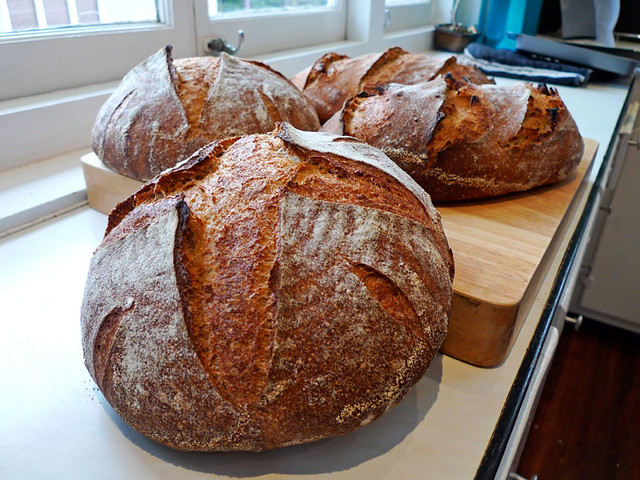 [/url]
[/url]
For this weeks bake I prepared two wholewheat boules and two fig and anise batards, all with freshly milled wheat.
Refreshing desem starter
[url=http://www.flickr.com/photos/67856223@N06/6193643952/]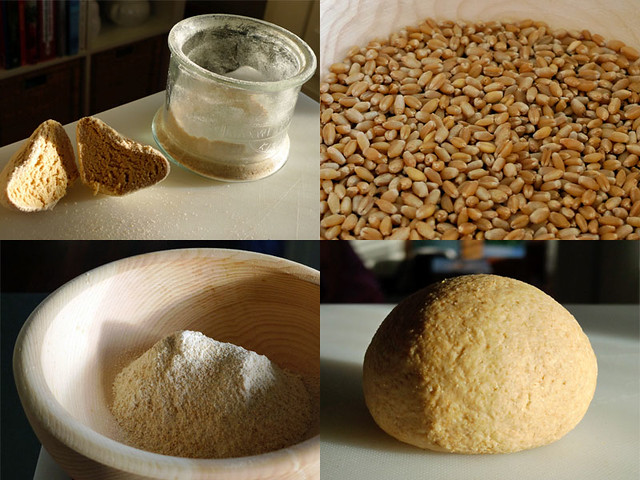 [/url]
[/url]
As we had so many bodies sleeping in our house I changed my usual method of milling right before mixing to allow them a more dignified morning wake up. Instead I milled the night before and added all the water and salt and soaked the fresh flour until the morning where I added the ripe starter. The same dough formula was used for both batches with the batards having extra mix-in ingrediants added during folding.
Wholewheat sourdough (with optional fig 'n' anise)
Total dough weight: 2kgs
Hydration: 85%
Prefermented Flour: 10%
DDT: 23°C
Whole wheat starter @ 60% Hydration: 175g
Wheat Flour Freshly milled: 973g
Water: 855g
Salt: 21g
Optional Mix-ins
Figs sliced: 375g
Anise seeds: 15g
Night before
Cool grains from fridge milled before being mixed with all water and salt.
Next morning
With wet hands squeeze and incorporate starter into overnight soak until smooth and feel no lumps then place in oiled see-through container (for checking dough development).
Bulk ferment roughly 4hrs with four stretch and folds 30min apart in the first 2hrs and another gentle stretch and fold at 3hr mark.
For the stretch and folds I tip the dough onto a bench which has been lightly sprayed with a water spray bottle/mister. The water stops dough sticking and I can give it a really good letterfold before placing back in container.
Optional: Figs and anise are squeezed through dough after 2nd stretch and fold.
Watch temperatures and dough like a hawk nearing the end of bulk ferment...I sometimes cut it short by half an hour if he dough is starting to move to quickly.
Preshape and bench rest 20 min before gentle shaping. Shaped dough placed into bannetons with floured cloths.
Adding mix-ins and bench resting wholewheat
[url=http://www.flickr.com/photos/67856223@N06/6193127187/]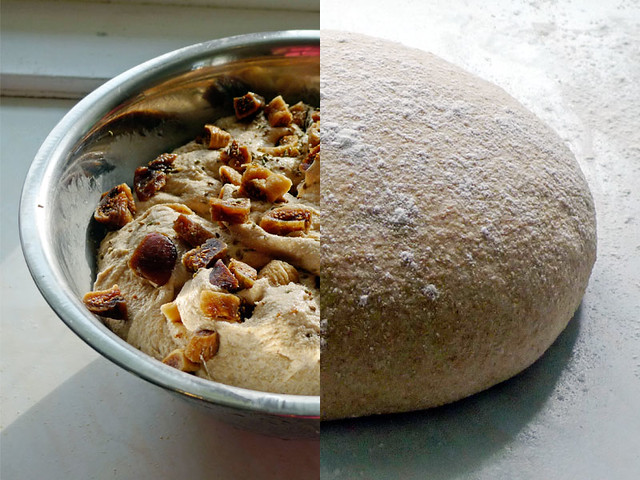 [/url]
[/url]
Final proof for wholewheat boule was roughly 1.5hrs at room temperature (23°)
Fig and anise proofed in fridge for 3hrs and was baked directly from fridge.
Bake boules in dutch oven at 250°C for 20mins then dough removed from dutch oven and baked at 20mins at 200°C directly on stone for thoroughly browning.
Batards were baked on stone with steam for first 10mins at 250°C then 200°C for 30mins.
Wholewheat boules
[url=http://www.flickr.com/photos/67856223@N06/6193644082/] [/url]
[/url]
Wholewheat crumb
[url=http://www.flickr.com/photos/67856223@N06/6193127523/]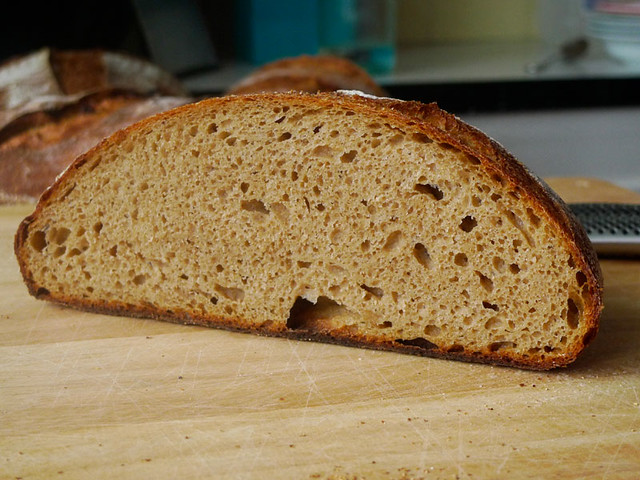 [/url]
[/url]
Fig and anise batard
[url=http://www.flickr.com/photos/67856223@N06/6193643700/]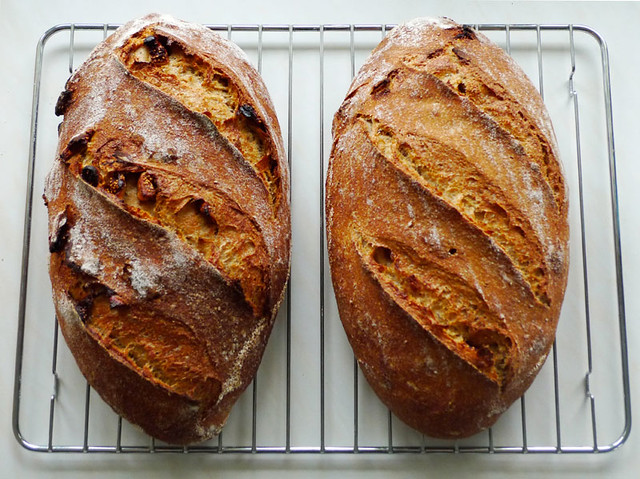 [/url]
[/url]
Fig and anise crumb
[url=http://www.flickr.com/photos/67856223@N06/6193127317/]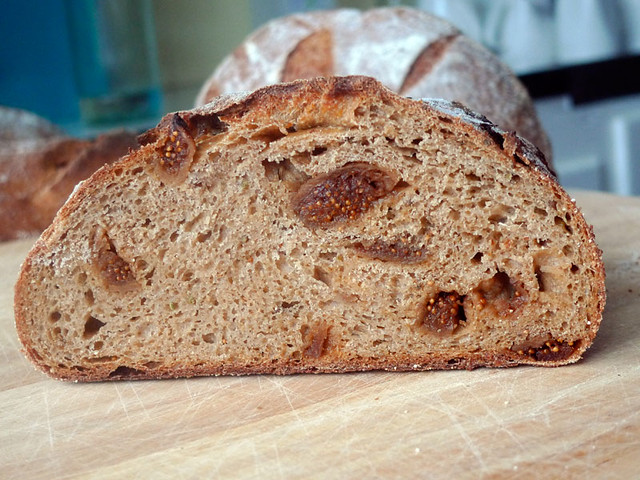 [/url]
[/url]
Breads were very well received and performed admirably at soaking up gravy...my roast was swimming in it :) The dutch oven really does give theses wholewheat breads the perfect crust....
The overnight soak is something I may use more often with my only issue being that it could be a little difficult to control dough temperatures. I can't say I have noticed any real difference with the bread itself using this method....just another handy option to have.
All the best
Phil
- PiPs's Blog
- Log in or register to post comments
Great looking loaves, Phil.
-Floyd
Hi Phil,
What a great write-up, and marvelous breads you made! I also like your photography.
The oven spring,crumb and crust...everything is remarkable.
I think that your family is proud of you as a great baker who makes bread with all your heart..I respect all of bakers who milled the grain by themselves. All of the breads must be really tasty.
Thank you very much for sharing!
I really enjoyed your post,
Akiko
Wow Phil,
Beautiful bake and your fig batards sounds delicious. I've never used figs in breads. It looks quite delicious.
Eric
Fig and anise bread does not last long in our house...a scraping of blue cheese (if you like that sort of thing) on a grilled slice with a glass of red in hand is just magic....goes just as well with marmalade for breakfast.
Beautiful pictures too! Love the splice shot with the dough and bowl/boule, plays of light and dark, before and after. Well framed photos all!
Thanks, I am really enjoying the process...Gets the brain working too :)
WOW!!!! ...........What beautiful loaves! Lovely to see those the first thing in the morning. You made my day, already! :)
Thanks for sharing, Phil.
lumos
Hi Phil,
Your pictures are great and the loaves look wonderful. I am impressed with the spring on the boules. I have never been able to get mine to have ears/gringe like you do...not sure of the correct word for the 'edges' of your scoring that stick out....I am thinking it is due to your hydration level....My HL levels are usually around 75% whereas yours is 85%! When I have tried that high of a HL I end up with frisbee loaves - ie...flat loaves. :-/
On soakers: I use them all the time with my freshly milled grains. One trick I learned over the summer when the temps here were high was that of mixing them up and placing them immediately into the refrig. for a few hours - usually about 4 hours - and then putting them out at room temp. (Basement 70-72°) for the remainder of the soak time. Works great! Only challenge I find with soakers comes when mixing them together with the leaven when the hydration is low....hard to blend them together without a mixer to get it started. It is amazing how much of a head start the gluten development gets using a soaker.
I will have to give your higher hydration level a go on my next lean dough loaf.
Thanks for posting your work.
Take Care,
Janet
Side note. Tried your method of feeding my starter today at 1:1.2:2. Dough temp. was 68° and room temp. was 68°. It ripened within 5-6hrs!!! I am doing a 50% hydration feed tonight and will see if that slows the wee beaties down a bit.
Hi Janet,
I think the ovenspring is probably not so much the hydration, but more to do with shaping and using a screaming hot dutch oven. I would say the boules maybe slightly underproofed by the gringe popping up, but I prefer that than overproofed...I tend to be a bit cautious (a chicken) with wholewheat. I tried 90% hydration last week with the wholewheat and can say I found no real improvement in crumb or texture...think 85% could be a winner for me.
Good luck experimenting with the starter....the warmer temperatures are almost upon us here...think I will be changing the ratios soon a well.
My starter got taken back to 50% hydration for its week in the fridge....it had a later feeding than normal and it was a bit gooey...
cheers,Phil
Phil,
I will have to re-visit higher hydrations and see what happens with my loaves. When I used to do higher HL the dough would get way too slack as it proofed and then it would really flatten out when put onto the stone or into a DO. The resulting loaves were flatter than my family liked. I have gone in the other direction to get the consistency I want after proofing and in the final loaf but spring is not the same....more experimenting.
Maybe your spring was due to underproofing...I only say this because I have experimented with hot DO vs cold DO and I have found no difference in the final outcome. I did this several times with the same doughs going into the oven at the same time.....I really wanted to see some sort of a difference but I have never gotten one....
The builds with my starter did make it to 10+ hours the other night so now I know what to do to stretch my final build....still toying around with my day time builds. Trying for a 5 hour ripening schedule ala Geraud Rubaud technique for his milder starters....ultimately I would like to keep my starter on the counter all of the time again with frequent builds throughout the day and a long stretch overnight (just like my nursing rhythm when my kids were infants)....but what happens with me is if I have ANY extra starter I feel compelled to build it up for a loaf so as not to waste anything....Khalid coined this behavior as CBS.....Compulsive Baking Syndrome. :-)
Take Care,
Janet
Another thought which I forgot to mention is the scoring. I find that a scoring the boules with a cross (+) leads to a higher spring. I remember reading somewhere that this type of score leads to a higher spring as opposed to say a diamand or square pattern (ie four slashes around the perimeter) as the loaf doesn't have to lift up a "lid"...can't think of any other way to describe it....(this is especially helpful when a loaf has mix-ins and has a lot to lift)
With a cross cut the centre can raise higher and open out...may also explain the gringe I am getting...
Just a thought.
cheers, Phil
Phil,
That was one thing I hadn't paid attention to. Next boule I will give it a go and see what happens. (I usually do the square cut so I do understand about the dough having to lift....ww needs all the help it can get and here I was giving it another obstacle to deal with :-)
Thanks for the insight...
Take Care,
Janet
Phil,
Experimented today....inconclusive results.....The loaves with the cross cuts appeared the same as the one with the box cut....I hate it when that happens :-)
I will do this several times and see what happens...
Take Care,
Janet
Yeah I hate that too...so many variables go into a loaf of bread and through it all they appear in one form or another...part of the fun.
I liked the quote from Richard Bourdon in Thom Leonard's "Bread Book" about the baker finding the balance point between contractive and expansive elements at play in the bread.
I am not sure if the slash is the answer for you....was just a thought. I actually prefer a box cut myself :)
cheers, Phil
Me too.
Bottom line is the taste was excellent in ALL loaves. :-)
J
Phil,
I finally got around to the fig and anise combination yesterday.....kept nagging at me so I gave in.
Changed a few things since I do the over-night retarding rather than day as you do which meant I increased the leaven % to 30% - also to aid with the sugar content from the figs....
I also simmered the figs. Cut them up into little pieces and then cooked them for a bit until they were very soft which meant the fig sugars were dispersed throughout the entire dough hence more leaven.
For the anise I used seeds and cut your amount down a bit not knowing how the flavor would come across.....picky bread tastes here.
The dough was wonderful to work with due to the figs - smooth and very elastic. The people who got some of the rolls I made (Did rolls rather than a whole loaf so I could get a lot of feedback from more people.) all LOVED them! This is definitely a bread I will be baking again...and again and again...I never would have though anise and figs would complement each other so well.
Take Care and thanks again for the post!
Janet
Its a winning combination in my book ... but it can have a polarizer effect on some people. They either love it or hate it :)
We sometimes bake these as rolls or panini ... quite a bit crustier but lightly toasted them really brings out the anise aromas.
I like your idea of cutting and simmering the figs. Dan Lepard has a formula with figs, pine nuts and red wine ... I think he simmers the figs as well but I can't remember of the top of my head.
All the best,
Phil